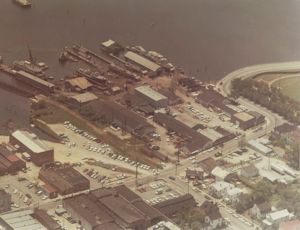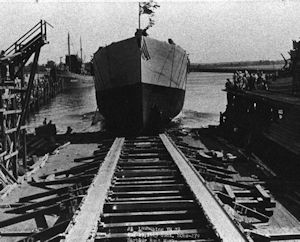
The N.C. History Center circulates much of the stormwater generated on the site through restored wetlands instead of dumping it directly into the Trent River. Photo: N.C.History Center
Supporter Spotlight
NEW BERN — A once-prosperous boat-building yard that became a toxic-laden Superfund site is now the home of an award-winning brick and glass waterfront showpiece that serves as a model in “green design.”
That design and innovative methods to control polluted runoff won The N.C. History Center a Pelican Award from the N.C Coastal Federation this year.
The center’s gleaming glass rose from the site of the old Barbour Boat Works. Founded in 1932 on the north bank of the Trent River, the boatyard produced all types of ships, from private yachts to tugboats and minesweepers. However, when it closed in the mid-1980s, it had become polluted with dangerous toxic chemicals that were contaminating the river.
 A variety of ships were built at the the Barbour Boat Works during its more than 50 years of operation. |
 A ship glides down the rail ways at the Barbour Boat Works in 1943. Photos: Digital Collections, Joyner Library, East Carolina University. |
The state bought the property in 1997 because of its proximity to Tryon Palace, the reconstructed 1790s’ governor’s mansion. The state intended the old boatyard to eventually become a visitors’ gateway to the palace and a museum that uses modern information technologies to tell the story of colonial coastal North Carolina.
The site presented several challenges, however. A marsh in colonial times, the location had become a Superfund site after decades of industrial use had contaminated the soil with PCBs, asbestos, mercury and heavy metals, not to mention vast quantities of coal tars left over from the 1800s.
Supporter Spotlight
The soft riverfront soil presented the project’s engineers with another set of challenges and acquiring the $60 million that would eventually be needed from private and public sources required a deft, sustained fundraising effort.
Philippe Lafargue, acting director for Tryon Palace, said that one of the project’s top priorities was to demonstrate good stewardship of the land and to promote innovative site-development methods.
“It was our only way of connecting one of our properties directly with the water. In the 18th century Tryon Palace was connected to the river,” he explained. “In the 1950s, a road was put between the river and the property. It was important to reconnect to the water—that’s why New Bern got developed. This (construction) was kind and good for the river as well as practical and to be used as a teaching tool not only for history, but in wetland construction.”
To pay for the new wetlands, Tyron Palace received a grant for $1 million from the N.C. Clean Water Management Trust Fund and $75,000 for the U.S. Environmental Protection Agency, Lafargue said. “We then hired an engineering firm, then a wetlands consultant and started designing the wetlands,” he added.
BJAC, an architectural firm in Raleigh, designed the stunning building. “One of the biggest challenges in the design of the museum was most certainly the magnitude of the project and the 11-year duration,” said Jennifer Amster, who headed the project team for the company. “We had a number of unique issues, such as having to handle the site remediation requirements to convert a brownfield into a sustainable waterfront and museum. But in the big picture, we were tasked with merging 300 years of history with today’s technology into a space designed to be in use and still sustainable 100 years from now for the New Bern community and its visitors. It was a massive undertaking.”
Ground was finally broken in 2008 and the center opened in October 2010 — just in time for New Bern’s 300-year anniversary. The resulting museum was well worth the wait. The two-story building was designed to reflect the earlier use of the property as a boatyard and to complement the adjacent Tryon Palace.
 Jennifer Amster |
Stormwater from both the History Center roof and the surrounding neighborhood now drains into a 35,000-gallon underground cistern that catches the runoff and uses a majority of it to irrigate the grounds. The remainder is sent through a series of pools that filter out sediment and pollutants before flowing into the river.
The strategically-selected and -placed native plants also reduce flooding by absorbing excess water. The plants were chosen for their suitability to natural light, moisture and soil conditions. Natives are also less labor intensive and cheaper to maintain than other types of plants because they require less fertilizing and fewer herbicides. They also provide habitat to wildlife.
The 600,000-square-foot building was built using 30 percent recycled materials, such as concrete, steel, metal doors, carpet fibers and linoleum. Using materials within a 500-mile radius of the center also reduced the transportation costs. Construction waste was reduced by 75 percent.
The interior of the museum also benefitted from the design and use of green materials. The paint, carpet and construction adhesives were selected for their minimal off-gassing properties. The air handling system uses higher levels of outside air and also increases the amount of air circulated throughout the building. The building is energy efficient with modulating electric lighting, occupancy sensors, increased building insulation and the use of premium energy-efficient HVAC equipment. Low-flow faucets, showers and urinals conserve water, and the permeable pavement in the parking lot reduced stormwater runoff.
 Numerous recycled materials were used inside the center, Photo: N.C. History Center. |
Aside from getting the federation’ Pelican Award, the museum is the first certified Leadership in Energy and Environmental Design museum in North Carolina and the first such building in New Bern. The construction has received the 2011 Star Award for a new construction over $20 million from the Construction Professionals Network of North Carolina.
“It took great vision, commitment and dedication by Tryon Palace and partners to complete the lengthy project of transforming the once polluted shipyard that contained asbestos, PCBs and other toxic chemicals into a public museum site that showcases environmentally friendly development and stormwater techniques,” said Lauren Kolodj, deputy director for the federation.
Amster added: “It was an incredible and challenging experience. It’s rewarding to visit the museum and reflect back on our accomplishments. We created a place that will enrich the public through education and bolster the local economic footing for the future.”







